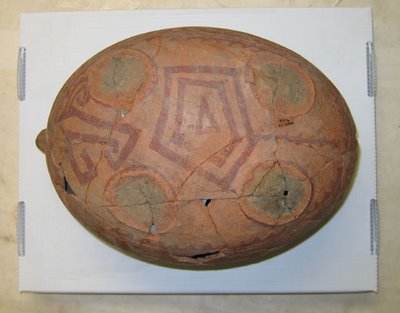Saturday, December 16, 2006
A useful talent. For some reason I can piece together broken pots really fast and make everything fit well. Give me a pot, a conservator-approved glue, and some masking tape- in an hour or two I'll have it reconstructed.
Last week the ceramic expert at work asked me to put together a very unusual pot. It is actually uncommon to reconstruct pots nowadays- they take up more space at the museum we send the artifacts to, and that costs more money. So generally, they get sent in the way they come in from our dig sites- bagged together and broken.
In this case, the fragments of the pot had unusual round areas where something had broken off. I thought it was an effigy vessel- made to resemble an animal.

Side view.
I laid the hundred or so pieces out and started at the bottom, quickly determining that the round areas were the places where ceramic legs had once attached and broken off, way back when the pot was being used. The red-on-brown designs indicates it dates to around A.D. 1100-1350. As I fit on the pieces making up the curved sides, I found that a head that had been at the front of the pot had also been broken off and lost. The little pointed tail was intact. I finished by attaching the round opening at the top. It took about two hours. The next day I removed the masking tape. Everyone who looked at the vessel were amazed at its large size and unusual shape.

Bottom showing round areas where legs were once attached.
Originally it was probably a dog, deer, or bighorn sheep. It may have had some ceremonial significance, but this is uncertain. After the legs broke off it was still used, as seen by wear on the vessel's base. It was found on the floor of a pithouse, lying among several other vessels left behind when the structure burned down.
Just to be clear- the last thing I would do is sell artifacts or loot sites. So many sites have been destroyed by people looking for artifacts to sell- often digging through graves to look for pots or other items. Everything I find ends up at a museum, where they are kept for future researchers and some of the more interesting items placed on display. The reports that I write describe the sites and artifacts in detail. Any burials (including all artifacts) are returned to the descendant communities for reburial.
Newer› ‹Older
Last week the ceramic expert at work asked me to put together a very unusual pot. It is actually uncommon to reconstruct pots nowadays- they take up more space at the museum we send the artifacts to, and that costs more money. So generally, they get sent in the way they come in from our dig sites- bagged together and broken.
In this case, the fragments of the pot had unusual round areas where something had broken off. I thought it was an effigy vessel- made to resemble an animal.

Side view.
I laid the hundred or so pieces out and started at the bottom, quickly determining that the round areas were the places where ceramic legs had once attached and broken off, way back when the pot was being used. The red-on-brown designs indicates it dates to around A.D. 1100-1350. As I fit on the pieces making up the curved sides, I found that a head that had been at the front of the pot had also been broken off and lost. The little pointed tail was intact. I finished by attaching the round opening at the top. It took about two hours. The next day I removed the masking tape. Everyone who looked at the vessel were amazed at its large size and unusual shape.

Bottom showing round areas where legs were once attached.
Originally it was probably a dog, deer, or bighorn sheep. It may have had some ceremonial significance, but this is uncertain. After the legs broke off it was still used, as seen by wear on the vessel's base. It was found on the floor of a pithouse, lying among several other vessels left behind when the structure burned down.
Just to be clear- the last thing I would do is sell artifacts or loot sites. So many sites have been destroyed by people looking for artifacts to sell- often digging through graves to look for pots or other items. Everything I find ends up at a museum, where they are kept for future researchers and some of the more interesting items placed on display. The reports that I write describe the sites and artifacts in detail. Any burials (including all artifacts) are returned to the descendant communities for reburial.
